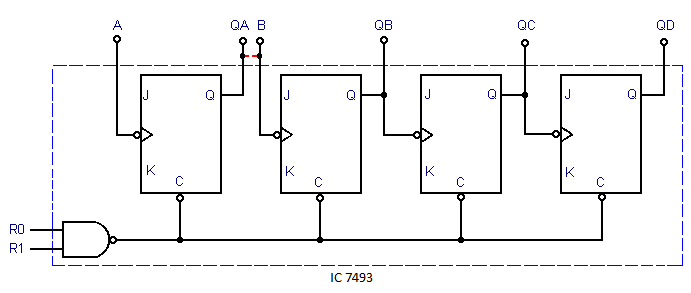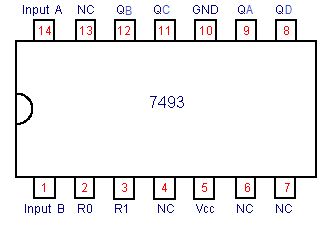This set of Digital Electronics/Circuits Multiple Choice Questions & Answers (MCQs) focuses on “Counter ICs”.
1. What is the difference between a 7490 and a 7493?
a) 7490 is a MOD-10, 7493 is a MOD-16
b) 7490 is a MOD-16, 7493 is a MOD-10
c) 7490 is a MOD-12, 7493 is a MOD-16
d) 7490 is a MOD-10, 7493 is a MOD-12
View Answer
Explanation: The difference between a 7490 and a 7493 is that 7490 is a MOD-10, 7493 is a MOD-16 counter. Thus, 7490 traverses 10 states and 7493 traverses 16 states.
2. How many different states does a 2-bit asynchronous counter have?
a) 1
b) 4
c) 2
d) 8
View Answer
Explanation: For a n-bit counter, total number of states = 2n. Thus, for 2-bit counter, total number of states = 22 = 4.
3. A 12 MHz clock frequency is applied to a cascaded counter containing a modulus-5 counter, a modulus-8 counter, and a modulus-10 counter. The lowest output frequency possible is ________
a) 10 kHz
b) 20 kHz
c) 30 kHz
d) 60 kHz
View Answer
Explanation: Cascaded counter containing a modulus-5 counter, a modulus-8 counter, and a modulus-10 counter. So, 5*8*10=400. Applied clock frequency = 12 MHz; hence, the lowest output frequency possible is 12MHz/400=30 kHz.
4. Which one is a 4-bit binary ripple counter?
a) IC 7493
b) IC 7490
c) IC 7491
d) IC 7492
View Answer
Explanation: IC 7493 is a 4-bit binary ripple counter. It is a MOD-16 counter with 24 = 16 states.
5. IC 7493 consist of ____________
a) 4 S-R flip-flop
b) 4 J-K flip-flop
c) 4 master-slave flip-flop
d) 4 D flip-flop
View Answer
Explanation: IC 7493 consist of 4 J-K master-slave flip-flop. It is a MOD-16 counter with 24 = 16 states.

6. A reset input is used in IC 7493, why?
a) For increment of bit by 1
b) For decrement of bit by 1
c) For reset the counter
d) For setting the counter
View Answer
Explanation: The reset inputs are used to reset the counter to 0000.
7. In a 4-bit binary ripple counter, four master-slave flip-flops are internally connected to provide a ________ bit counter.
a) Divide-by-2 & divide-by-6
b) Divide-by-6 & divide-by-8
c) Divide-by-2 & divide-by-8
d) Divide-by-4 & divide-by-8
View Answer
Explanation: In a 4-bit binary ripple counter, four master-slave flip-flops are internally connected to provide a Divide-by-2 & divide-by-8 bit counter.

8. Which of the following is a decade counter?
a) IC 7493
b) IC 7490
c) IC 7491
d) IC 7492
View Answer
Explanation: IC 7490 is called as decade counter or MOD-10. Thus, it has 10 states.
9. In a 4-bit decade counter, four master-slave flip-flops are internally connected to provide a ________ bit counter.
a) Divide-by-2 & divide-by-6
b) Divide-by-6 & divide-by-8
c) Divide-by-2 & divide-by-5
d) Divide-by-4 & divide-by-8
View Answer
Explanation: In a decade counter, four master-slave flip-flops are internally connected to provide a Divide-by-2 & divide-by-5 bit counter.
10. Reset inputs are used in IC 7490, why?
a) For increment of bit by 1
b) For decrement of bit by 1
c) For reset the counter
d) For setting the counter
View Answer
Explanation: The reset inputs are used to reset the counter to 0000.
11. The set inputs are used in a decade counter, why?
a) To set the counter to 0011
b) To set the counter to 1000
c) To set the counter to 1001
d) To set the counter to 0001
View Answer
Explanation: The set inputs are used in a decade counter to set the counter to 1001 which is 9 in decimal, as a decade counter counts from 0 to 9.
12. List which pins need to be connected together on a 7493 to make a MOD-12 counter.
a) 12 to 1, 11 to 3, 9 to 2
b) 12 to 1, 11 to 3, 12 to 2
c) 12 to 1, 11 to 3, 8 to 2
d) 12 to 1, 11 to 3, 1 to 2
View Answer
Explanation: IC-7493 is a MOD-16 counter. So maximum, it can have 16 states. A MOD-12 counter will have 12-states. Thus, it is clear from the diagram shown below: 12 & 1 are clear pins, 11 & 3 are clock pins, 8 & 2 are input for 7493 FF.

13. Ripple counter IC has _____________
a) 10 pins
b) 11 pins
c) 12 pins
d) 14 pins
View Answer
Explanation: A ripple counter is of 4-bit and has 4 J-K flip-flops. Ripple counter IC has 14 pins.

14. Integrated-circuit counter chips are used in numerous applications including ____________
a) Timing operations, counting operations, sequencing, and frequency multiplication
b) Timing operations, counting operations, sequencing, and frequency division
c) Timing operations, decoding operations, sequencing, and frequency multiplication
d) Data generation, counting operations, sequencing, and frequency multiplication
View Answer
Explanation: There are no integrated circuit counter chips employed for frequency multiplication. In the rest of the options, frequency multiplication is mentioned which is not related to counters in anyway. So, they are not the correct answers. Thus, counters are used for timing operations, counting operations, sequencing and frequency division.
15. What is the difference between 7490 and a 7492?
a) 7490 is a MOD-12, 7492 is a MOD-10
b) 7490 is a MOD-12, 7492 is a MOD-16
c) 7490 is a MOD-16, 7492 is a MOD-10
d) 7490 is a MOD-10, 7492 is a MOD-12
View Answer
Explanation: From the properties of both ICs, we have 7490 is a MOD-10, 7492 is a MOD-12. Thus, IC-7490 can have maximum 10 states, while IC-7492 can have maximum 12 states.
Sanfoundry Global Education & Learning Series – Digital Circuits.
To practice all areas of Digital Circuits, here is complete set of 1000+ Multiple Choice Questions and Answers.
If you find a mistake in question / option / answer, kindly take a screenshot and email to [email protected]
